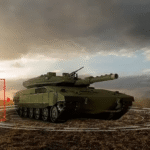GrandSKY Development Company has announced the establishment of a dedicated counter-unmanned aircraft systems (C-UAS) operations center at Grand Forks Air Force Base (AFB), North Dakota. The new facility is designed to serve as a national proving ground for advanced counter-drone technologies, integrating live testing with operational airspace surveillance and command-and-control (C2) systems. This initiative positions Grand Forks as a strategic node in the evolving U.S. air defense architecture against low-cost aerial threats.
Strategic Role of Grand Forks AFB in the C-UAS Ecosystem
Located adjacent to one of the most active remotely piloted aircraft hubs in the United States, Grand Forks AFB hosts platforms such as the RQ-4 Global Hawk and supports critical ISR missions. The base’s proximity to vast Class D and restricted airspace makes it ideal for complex air traffic integration experiments involving both manned and unmanned systems.
The new C-UAS operations center leverages this geography by enabling real-world testing against simulated or live “red” drone threats under controlled but operationally relevant conditions. According to Tom Swoyer Jr., president of GrandSKY Development Company, “This is not just about testing radars or jammers in isolation — it’s about building an end-to-end kill chain that can detect, track, identify, and neutralize rogue drones while maintaining situational awareness across military and civilian domains.”
Facility Capabilities: From Detection to Defeat
The operations center will host a range of government-vetted and commercial-off-the-shelf (COTS) counter-drone systems. These include:
- Passive RF sensors for early detection of drone control links
- Active radar systems optimized for Group 1–3 UAS targets
- Electro-optical/infrared (EO/IR) tracking payloads
- Electronic warfare modules capable of GNSS spoofing or RF jamming
- Kinetic interceptors such as net guns or directed-energy weapons under evaluation
The site is also expected to support software-defined C2 platforms that fuse multi-sensor data into a common operating picture (COP), enabling faster decision-making through AI-assisted threat classification and rules-of-engagement logic.
Integration with SkyRange and National Test Infrastructure
The initiative is closely aligned with SkyRange — a Department of Defense program led by the Test Resource Management Center (TRMC) that repurposes high-altitude Global Hawk UAVs for telemetry relay during hypersonic flight tests. The presence of SkyRange assets at Grand Forks enables seamless integration between counter-drone technologies on the ground and airborne ISR platforms operating at high altitudes.
This dual-use synergy allows real-time validation of sensor performance across multiple domains — land-based radar cueing EO/IR payloads aboard stratospheric UAVs or vice versa — which is critical for developing layered defense architectures against emerging threats like swarming drones or autonomous loitering munitions.
Civil-Military Collaboration and FAA Airspace Integration
One unique aspect of the GrandSKY effort is its emphasis on dual-use applicability. The facility operates within FAA-sanctioned test corridors managed by North Dakota’s Northern Plains UAS Test Site (NPUASTS), one of seven designated FAA UAS test ranges in the U.S. This allows developers to evaluate how C-UAS tools might function near airports, power plants, or urban centers without violating national airspace rules.
The FAA’s Beyond Visual Line-of-Sight (BVLOS) waiver granted to NPUASTS plays a key role in enabling extended-range drone operations — essential both for red-team simulations and blue-force response drills. As part of its civil-military integration model, GrandSKY also collaborates with DHS agencies tasked with protecting critical infrastructure from drone incursions.
Operational Relevance Amid Growing Drone Threat Landscape
The urgency behind this project stems from escalating use of small drones by state actors and non-state groups alike — from battlefield ISR in Ukraine to cartel surveillance along U.S. borders. Commercial quadcopters can be modified into weaponized FPV drones or used for GPS jamming missions against civilian aviation assets.
The Department of Defense’s FY2024 budget allocates over $668 million specifically toward C-UAS RDT&E programs across services. Meanwhile, Congress continues to debate expanded authorities under legislation like the Safeguarding the Homeland from Unmanned Aircraft Systems Act (SHUASA), which would broaden federal jurisdiction over drone interdiction beyond DoD facilities.
By standing up an integrated testbed that mirrors real-world complexity — including electronic clutter, spectrum congestion, legal constraints on engagement — GrandSKY aims to accelerate fielding timelines for viable countermeasures while informing doctrine development across combatant commands.
A Platform for Innovation Across Government and Industry
The new operations center will host regular technology demonstrations open to vetted defense contractors and federal stakeholders. These events will allow side-by-side comparisons between competing solutions under identical conditions — from AI-driven target recognition software to modular EW payloads deployable on mobile ground vehicles.
This model aligns with broader Pentagon efforts like DIU’s Blue UAS program or AFWERX Prime initiatives that seek rapid acquisition pathways outside traditional procurement cycles. It also provides smaller vendors a venue to validate TRL-6+ prototypes before entering programs-of-record competitions.
Outlook: Toward Scalable Counter-Drone Architectures
If successful, the GrandSKY hub could serve as a template for other regional C-UAS centers co-located with major military installations or critical infrastructure corridors such as ports or nuclear facilities. The long-term goal is not just point-defense but scalable architectures capable of defending wide-area battle networks under contested EM environments.
With adversaries increasingly investing in asymmetric aerial capabilities — including AI-enabled swarm tactics — initiatives like this are essential not only for homeland defense but also expeditionary force protection abroad.










